Creating a media frenzy over thirty years ago, it could have destroyed a globally respected brand. To recall just what happened, I interviewed retired Volvo PR Manager Bob Austin, a key player in what proved to be a template for effectively managing a potential corporate crisis.
The monster truck that nearly crushed Volvo
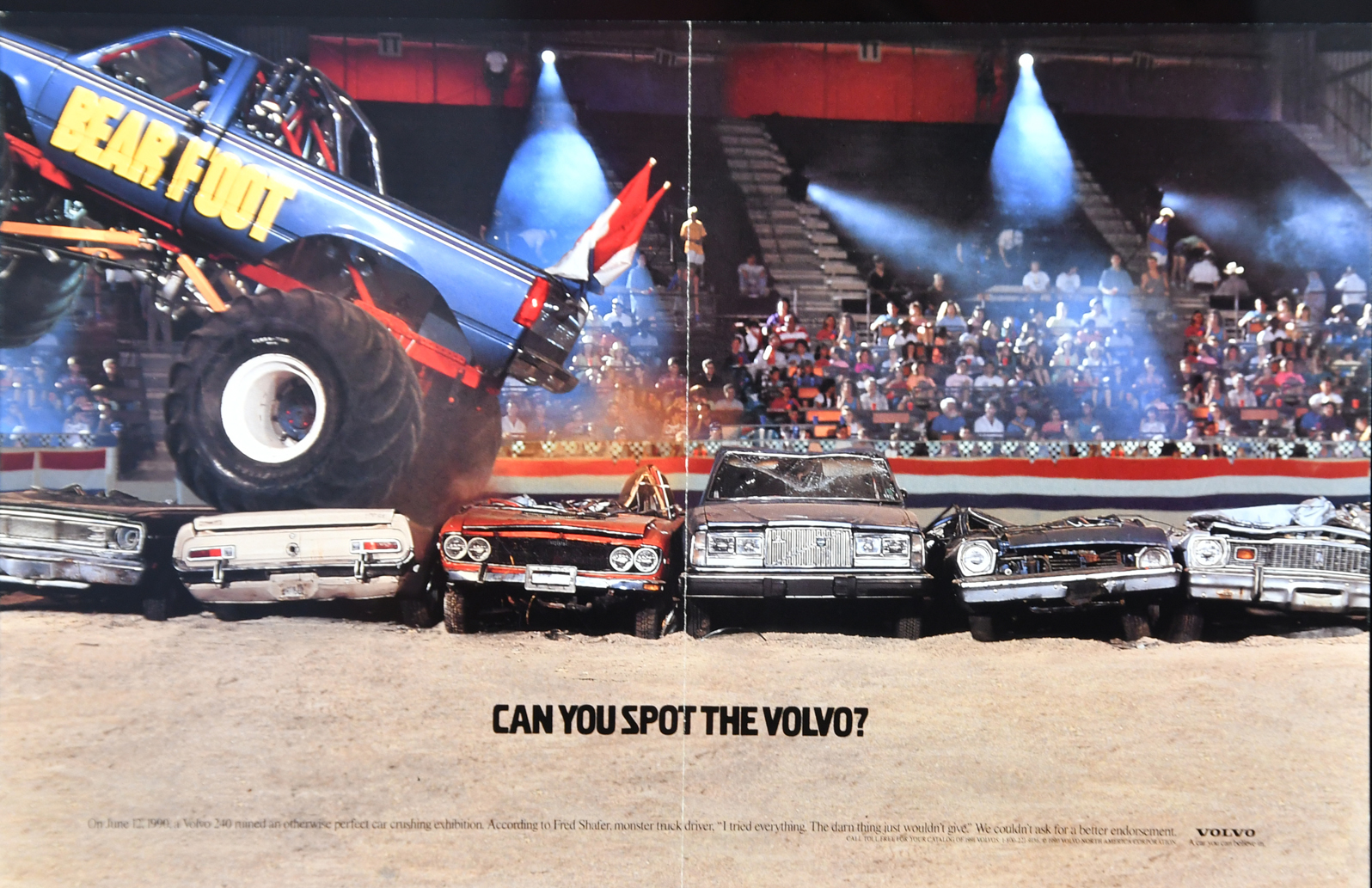
Inspired by car punishing monster truck events exploding on the scene in the late 1980s, Volvo in October of 1990 released a compelling TV commercial intended to promote its legendary rugged construction. Once broadcast, the ad would instead plunge Volvo into crisis.
On what should have been one of life’s better days, Volvo PR Manager Bob Austin’s honeymoon was interrupted by a phone call from Volvo Corporate Counsel, Bob Mercer. Mercer quickly popped Austin’s bubble of bliss and cut to the chase saying, “Can you be in the office tomorrow?” “What’s up?” asked Austin. “Better you should come in,” Mercer replied. Thus began what Austin, decades later, would recall as three of the most stressful months of his life.
At Volvo headquarters, sitting across from Mercer, Austin learned that the office of the Texas Attorney General, Jim Mattox would be charging Volvo with knowingly creating a fraudulent and misleading television commercial.
Looming as exhibit 1 supporting Mattox’s startling accusation stood the Volvo television and print campaign that would forever be known as “Monster Truck.”
Concerned to say the least, Mercer asked Austin if he knew anything that could account for this accusation. Austin stated that he was unaware of any problem. Mercer quickly changed that by dumping it squarely in Austin’s lap.
“Monster Truck” as a concept found its inspiration in an actual monster truck event held on September 11th 1988 in Essex Junction, Vermont.
By happenstance a person associated with Volvo’s ad agency at the time, Scali, McCabe and Sloves, while on vacation had attended that Essex Junction event. On that September day in a dynamic flurry of flying dirt, waving flags, and bleachers filled with screaming fans an airborne monster truck set out to crush a row of cars. After a few passes by the massive monster truck the agency employee realized that, unlike the other vehicles in the row of sacrificial cars, a lone Volvo had stood up to the pounding with its roof remaining defiantly upright. Inspired by what he witnessed, the vacationing employee acquired video of the event. Back home, he shared it with the agency’s Volvo account staff and quickly set creative wheels in motion.
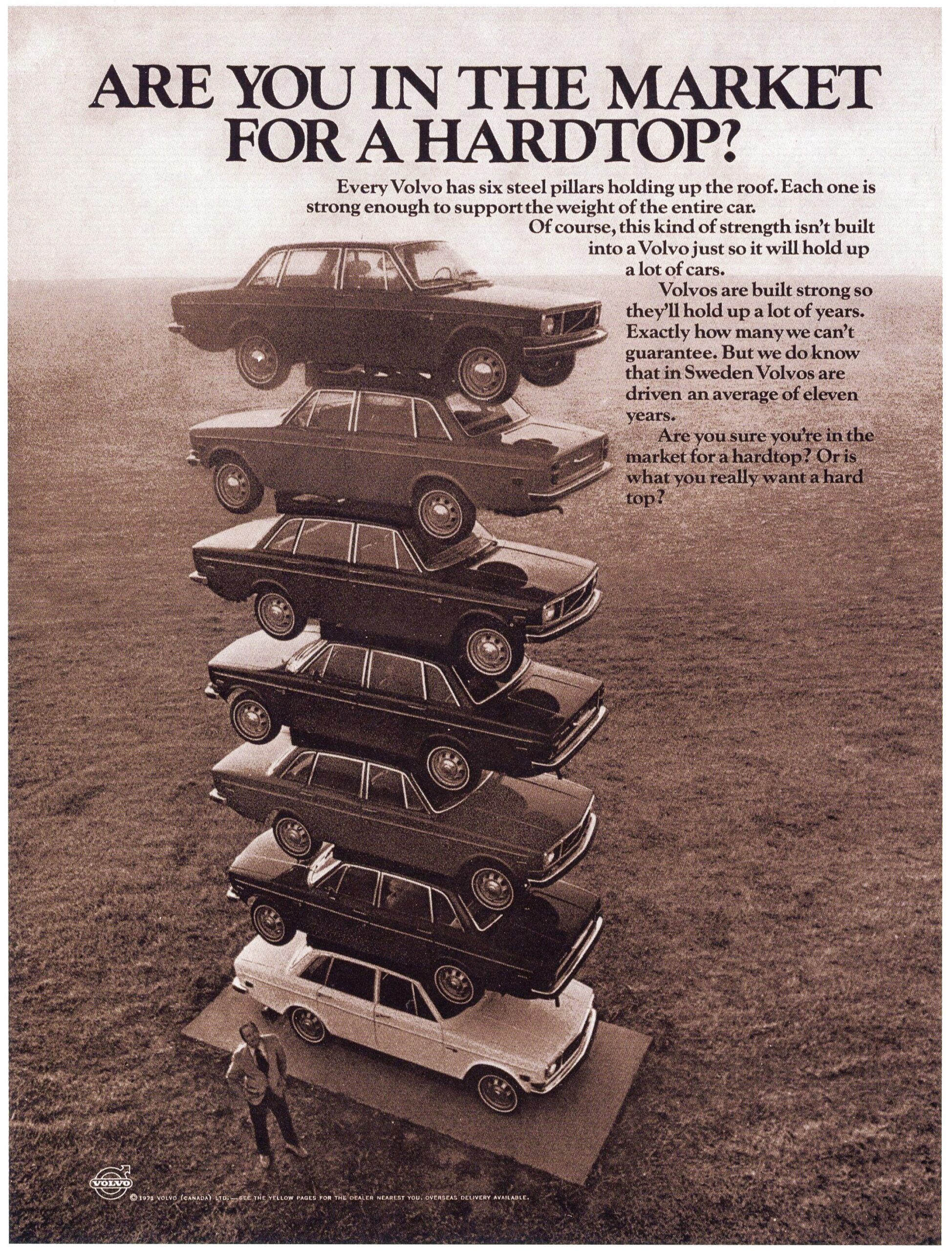
Historic Volvo ad touting roof strength
When Scali, McCabe & Sloves pitched the “Monster Truck” idea, a very interested Volvo responded by first reaching out to its engineers in Sweden to confirm that a Volvo 240 could indeed withstand such punishment.
Sweden responded with a resounding “Ya Sure.”. Engineers confirmed that each of a Volvo 240’s roof pillars had been designed to support the total weight of the entire vehicle, roughly 3,000 pounds. Doing the math, a Volvo 240 wagon with its 8 pillars should support about 24,000 pounds. Confidently, Volvo engineers concluded that the Volvo roof could easily support a typical monster truck weighing roughly 12,000 pounds.
Armed with those assurances Volvo gave its approval. “Monster Truck” would be produced as a cleaner, clearer re-enactment of the original 1988 Vermont event.
According to Austin, Scali, McCabe and Sloves awarded the project to a production company which while relatively new enjoyed a high level of confidence with the agency as it was populated with trusted past employees of the agency. It also came in with the low bid.
With concept and team in place, attention turned to location. It had to have a dirt floor. Flying dirt would dial up the drama of the monster truck making rampaging bull charges at a stationary line of cars. Another “must” was bleacher seating to accommodate the wildly screaming fans cheering the mayhem. With slim pickings in the New York metropolitan area, an expanded search located an ideal venue. A rodeo arena in Austin, Texas fit the bill perfectly.
Vehicles gathered for the shoot included the monster truck, over a dozen random used cars and three used Volvo station wagons. The need for more sacrificial vehicles than would ultimately appear in the ad was necessitated by the nature of film making. Multiple takes of the same scene often occur in order to get the best shot. When the repeated action requires a monster truck to punish a car, wear and tear can take a serious toll on the cars.
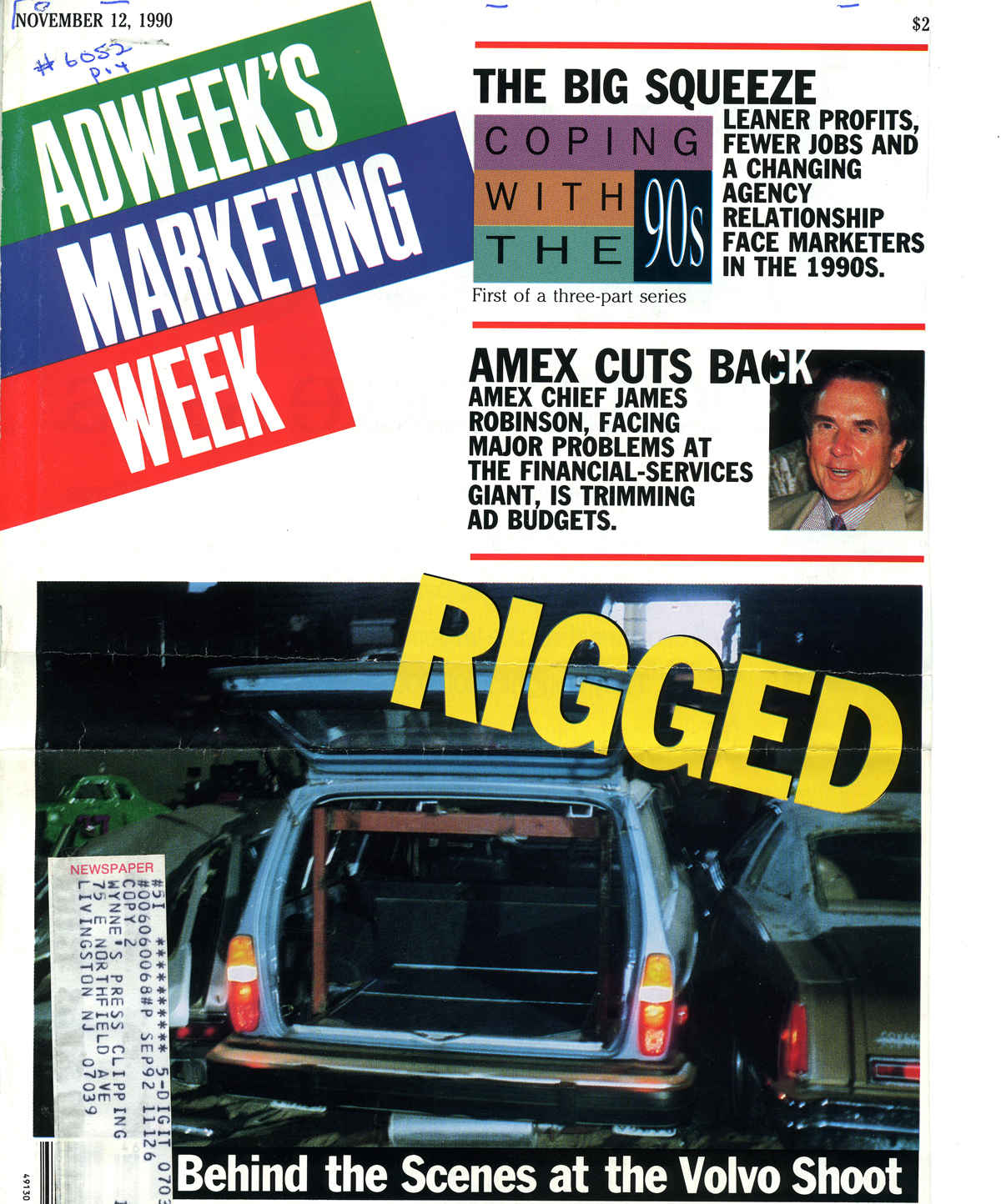
AdWeek front cover
To fill the bleachers with screaming fans, ads appeared in the local newspaper inviting people to participate in the filming of a Volvo commercial. Many people came. They fulfilled their role as rabid monster truck fans admirably. As directed, they wildly cheered for the destruction of helpless vehicles only to dissolve into a disbelieving cohort when confronted with a defiant crush resistant Volvo.
Once completed, Volvo management understood the filming to be uneventful and highly successful with the result being an attention grabbing television commercial dramatically and humorously promoting the signature strength and durability of Volvo cars. In other words, “Monster Truck” would add yet one more classic Scali, McCabe and Sloves execution to their Volvo commercial reel. Alas, it would not be so. Volvo, the company, now faced the even more punishing slow turning wheels of the Texas State Department of Justice.
With the threat of legal action looming over Volvo, Austin and Mercer, after speaking with agency management, sat down with members of the production team. They asked pointedly, did anything unusual happen during the production. Interviews with the production team affirmed that nothing of note was done to the cars. With due diligence completed, Austin, Mercer and the agency felt quite comfortable with their understanding of what had happened.
As Austin says, “We concluded that some of the extras who had been hired to be the audience had expected to see an actual “Monster Truck” event, one that takes place in real time. If an audience member had no experience in film production, he or she might have been confused by seeing the filming of one shot multiple times and the order of shots filmed in a non-sequential fashion.”
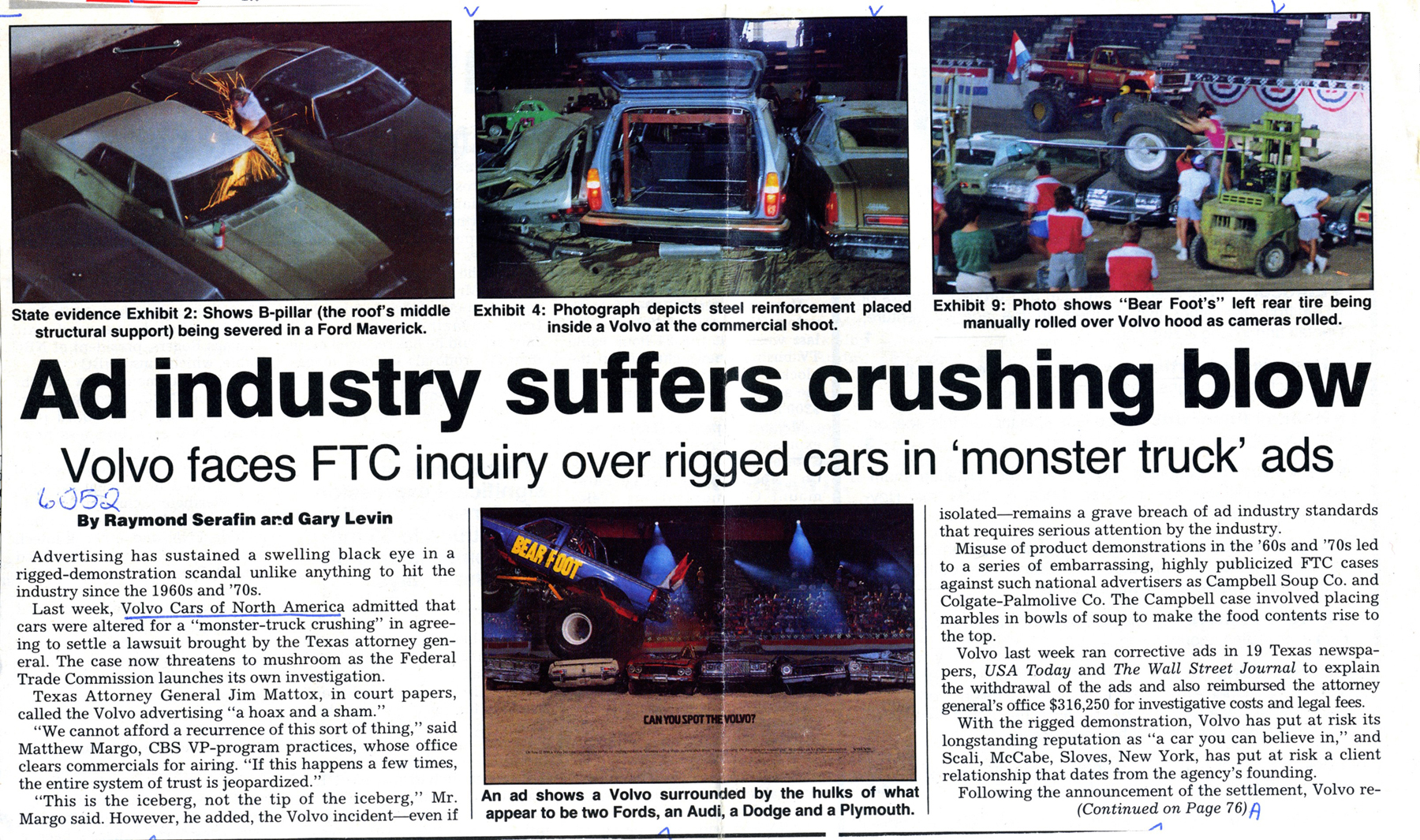
Volvo’s team confidently believed that surely this must be the cause of any misunderstanding.Creating a media frenzy over thirty years ago, it could have destroyed a globally respected brand. To recall just what happened, I interviewed retired Volvo PR Manager Bob Austin, a key player in what proved to be a template for properly managing a corporate crisis.
“Back then it was understood that being contacted by Texas AG Jim Mattox was a serious matter. That said, we felt pretty good,” says Austin. We were confident that we could explain that it was just a misunderstanding. Volvo’s team comprised of Austin, Mercer, Volvo’s Ad Manager and agency representatives prepared to fly to Texas to meet with Mattox. Actually, the Volvo team would be meeting with a member of the Attorney General’s staff William Goodman.
Austin recalls being greeted by a pleasant woman behind a desk who, upon welcoming the Volvo team, turned over her shoulder and with the signature regionalism of a Texas native called through an open door, “Bill, the boys from New York are here.”
With that auspicious welcome, Austin’s first thought was “Oh s%*t, we are in trouble.”
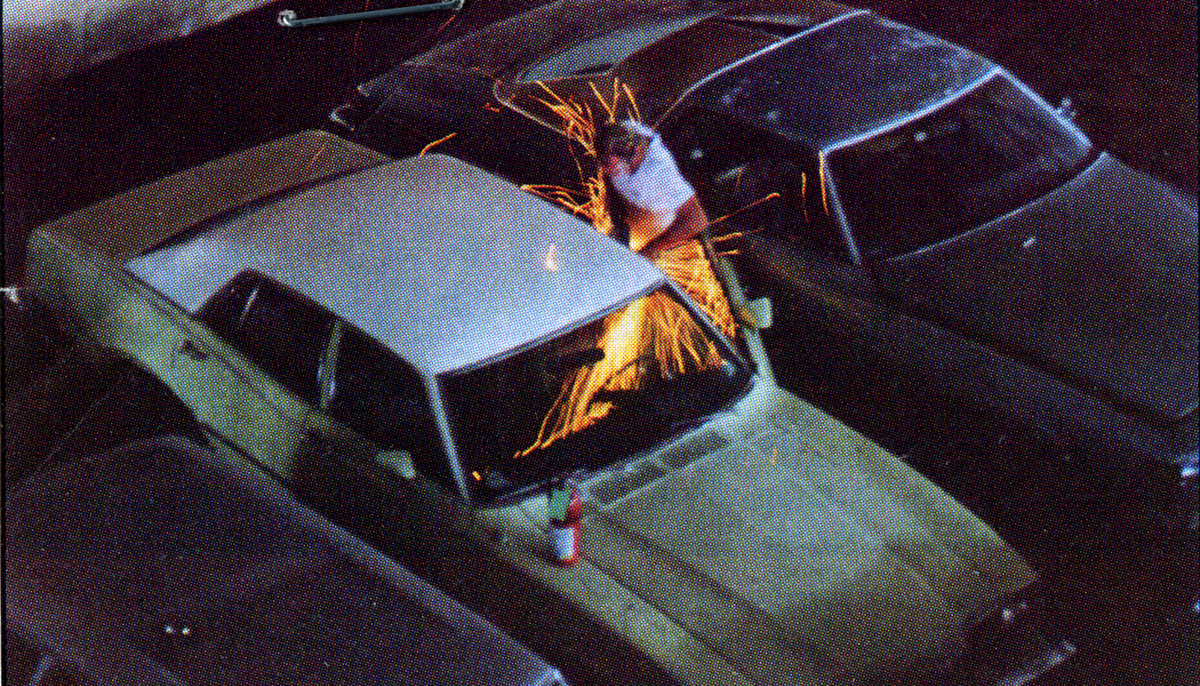
Image taken at filming
As the group turned to the open door, a man behind a large desk motioned them in with a distinctive Texas flair. Austin recalls, “He was dressed in a classic western style shirt with the snap flap pockets, he invited us to take a seat.” Three rows of chairs faced Goodman’s desk. Mercer and Austin, who would be representing Volvo, sat in the first row, the others retreated to the rear.
Mercer led off by reviewing the charges and Austin followed-up confidently explaining Volvo’s belief that it all was a misunderstanding based on some audience members’ unfamiliarity with the process of film making.
Seeking to clarify or some might say to firmly set the hook, the Goodman restated Volvo’s position that it was simply a misunderstanding. Austin confirmed that that was correct.
Like a fast hand gunslinger in a barroom shoot out, the attorney pulled out a stack of photos and said, “Then perhaps you can explain these.”
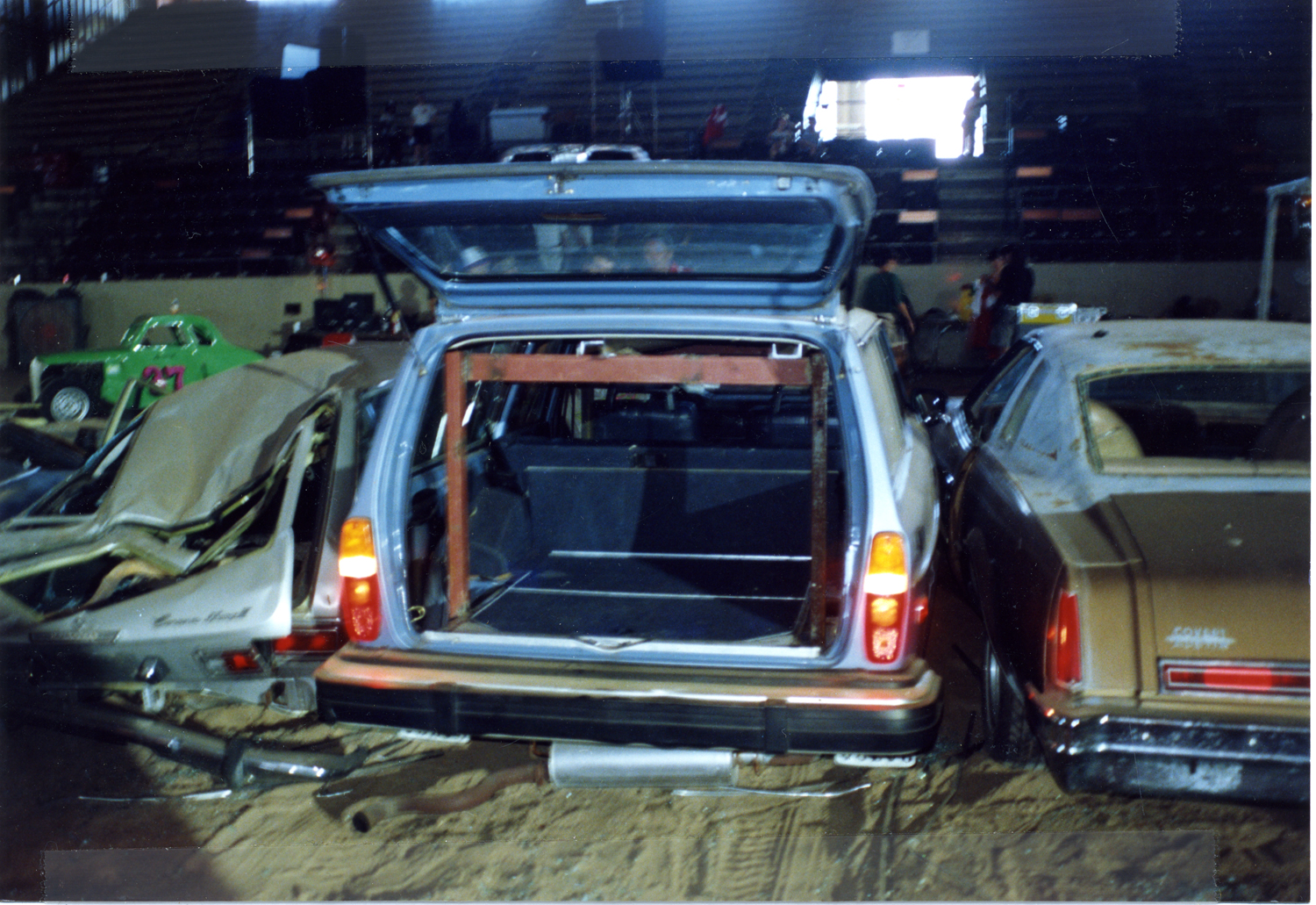
Image taken at filming
A tense silence filled the room as Austin slowly silently reviewed each photo before passing it to Mercer on his left. First came an image of the open tailgate of a Volvo 240 wagon with three 2-inch diameter tubes running from the floor to a cross member positioned horizontally under the roof. Next photo showed a man standing behind the side of a non-Volvo sedan with his shoulder raised as if he held a heavy object. A large ribbon of sparks shot out from the car past him. The next photos proved to be no less disturbing.
Accepting each from Austin, Mercer inspected each photo slowly in silence for what, Austin says, “Seemed like an eternity.”
Mercer broke the spell. He pushed back against the Texas attorney’s assumptions, saying, as Austin recalls, “I know you would like me to believe that these three tubes are there to support the roof. However, for all I know these three tubes could be a camera mount.” Mercer went on to suggest that the ribbon of sparks rather than caused by an effort to compromise the non-Volvo could be caused by the removal of a badge or other recognizable feature so that the car could not be identified.
While Mercer blunted the initial attack, the embarrassment and disbelief caused by these disturbing photos hung heavy in the room for the Volvo faithful. Agency members in the room sat mute and terrified. They too thought it had been audience misinterpretation.
As Austin recalls Mercer continued asserting that the two parties stood at an impasse. Mercer suggested that having the cars to view would certainly be a help. “No problem” fired back Attorney Goodman with a speed and finality not unlike a triggered leg trap. He continued, “We have them in storage close by. When do you want to look at them?”
All parties agreed to reconvene at the storage facility with Austin and Mercer alone representing Volvo.
After lunch the group assembled at the storage area where three battered Volvos awaited them. Two had not been altered in any way, but the third clearly displayed marks where pipes had been welded in. “As we left the facility,” Austin says, “Mercer and I agreed there was sufficient reason for someone who attended the shoot to question Volvo.”
This latest and disturbing turn of events demanded that Austin and Mercer confer with the passionate and fiery President of Volvo Cars of North America Joseph L. Nicolato. Austin says, “Cut Joe Nicolato and he bled Volvo blue. Take an action to hurt Volvo and Joe would defend the brand like a pit bull.”
A true old school, skilled and colorful leader, Nicolato, a former marine, once, at a WWII USO themed Volvo national sales meeting, arrived in a helicopter accompanied by Wagner’s “Ride of the Valkyries” wearing George C. Scott’s uniform from the movie “Patton.”
While Austin enjoyed Nicolato’s respect and confidence, Austin’s thick skin helped facilitate their good relationship. Austin understood that the possibility always existed for the messenger to take the initial heat for the message.
Joining Nicolato on the Volvo headquarters end of the conference call would be Executive Vice-President of Marketing William Hoover. Cool and controlled compared to Nicolato’s passionate and direct approach, Hoover shared Nicolato’s unwavering dedication to the Volvo brand.
“Neither Nicolato nor Hoover spoke as we debriefed them for the first third of the call,” recalls Austin. Both Nicolato and Hoover had dedicated their working lives to building the Volvo brand in North America. Now, what they heard had the potential to destroy much of what they had accomplished and seriously compromise one of the world’s most respected marques.
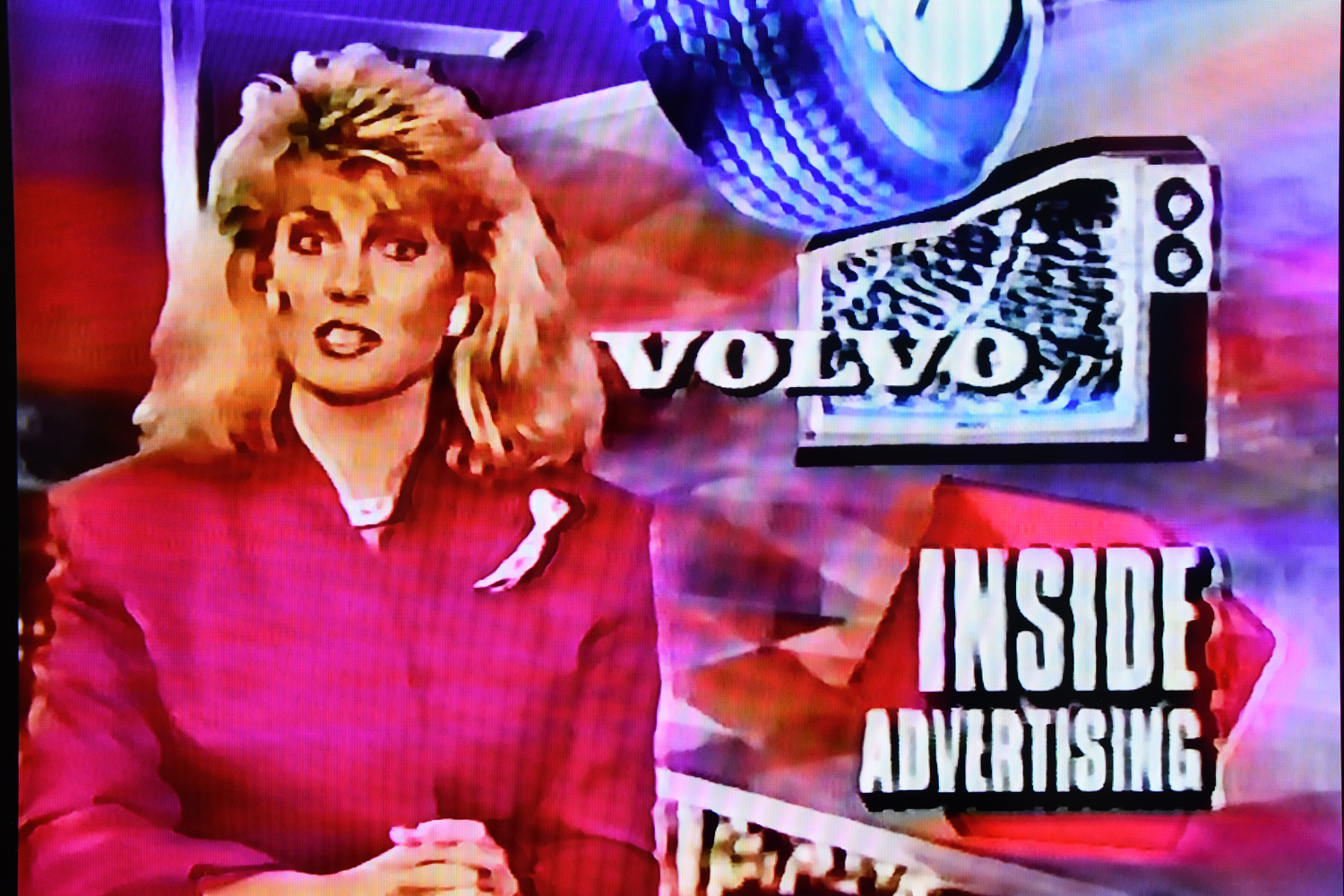
Television coverage
Horrified best described Nicolato’s and Hoover’s reactions. Infuriated and deeply concerned, Nicolato was not so much angered by the actions of the Texas AG as by this needless self inflicted wound. He was incensed by the apparent and unnecessary buttressing of a Volvo car by people who should have known better. Austin says, “Joe being Joe, the first moments of the second third of the call basically blistered the paint off the phone.”
However, Nicolato’s passion never interfered with his ability to get down to business. His storm quickly subsided. Nicolato knew important decisions needed to be made and make quickly. For Nicolato traditional corporate responses held no appeal.
Nicolato made it crystal clear that there was no way Volvo would retreat into the black hole of denial without closure. He believed such a “gutless” response could suck the life out of the proud Volvo name and it plain and simple did not represent the character of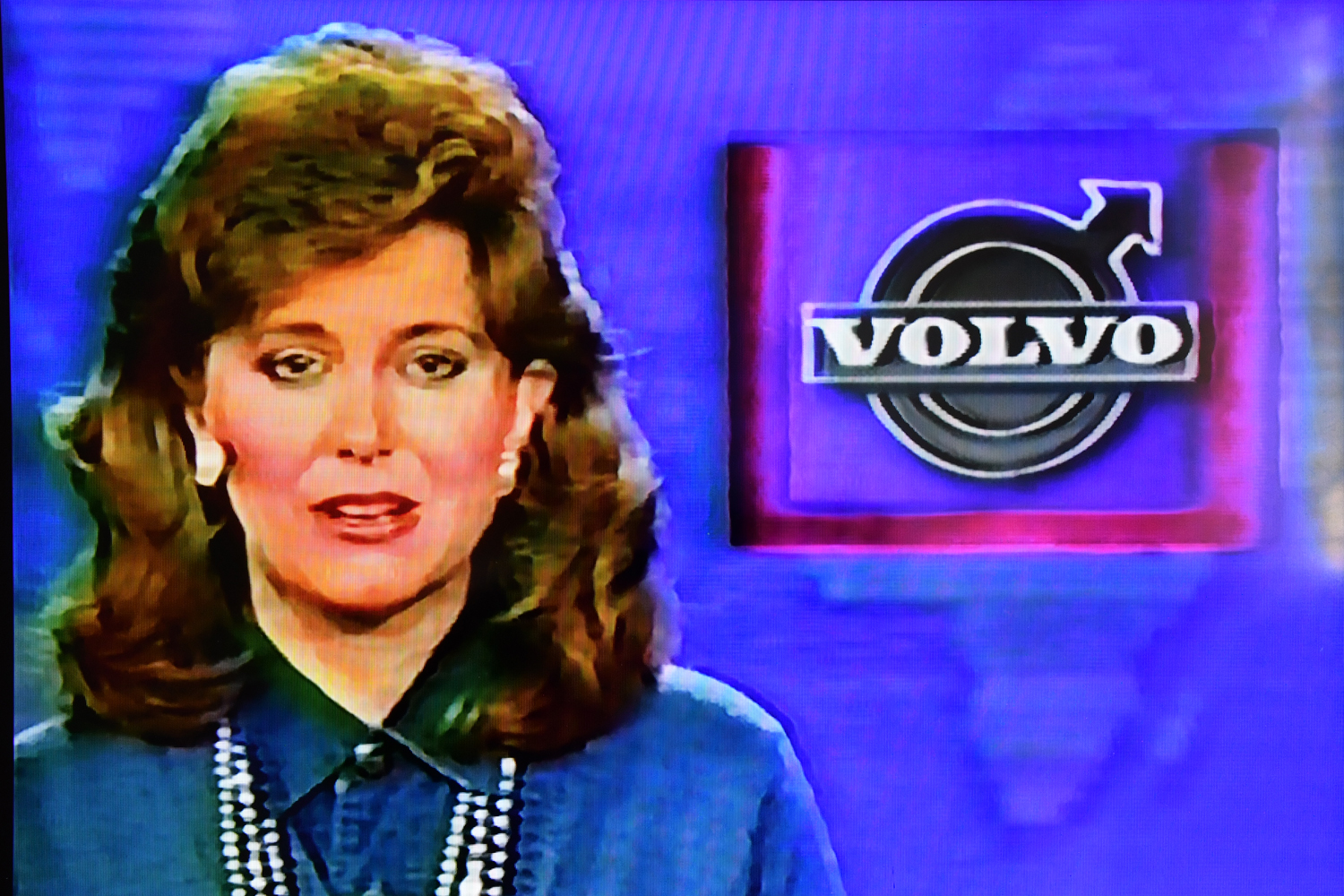 the Volvo brand or its people. All agreed.
the Volvo brand or its people. All agreed.
A second traditional response felt equally distasteful. Volvo could accept the allegations, pay a hefty fine and be left to slink off in disgrace while dragging Volvo’s good name behind it. Such an approach stood especially galling as the accusation of a willful intent to deceive was not true.
Nicolato wanted offense. Austin and Mercer delivered it with a proposal that defied tradition. Their approach took AG Jim Mattox by surprise. Volvo would acknowledge that mistakes had been made in the production of the commercial and take full responsibility. Crucially, Volvo’s position would be that the mistakes made did not alter what would have been the outcome had the mistakes not taken place.
Furthermore, to Mattox’s disbelief, Volvo executives volunteered to stand at the attorney general’s side and acknowledge those mistakes at a press conference. In addition Volvo would voluntarily produce advertising acknowledging the mistakes for both Texas and national markets.
Volvo also made clear that it would not admit guilt to intentionally producing a misleading ad. As such, no fine should be levied. Attorney General Mattox agreed, though he noted a considerable sum had been spent in pursuing the investigation. Volvo agreed to reimburse the AG for those expenses, a sum of $350,000.
At the subsequent AG’s press conference Executive Vice President Hoover stated, “A mistake was made in the production of a Volvo commercial,” “Do not confuse this with the fact that Volvos are strong and rugged. This commercial may have issues, but our cars do not.”
Today, in looking back, Austin, now retired, believes that the alterations initiated by the production company resulted from panic born of a confluence of difficulties unforeseen by the production company. One of the three Volvos sustained visual, but not structural, damage very early in the filming making it unusable. Additionally, as a new production company highly desirous of getting such a plum job, they bid the project with a sharp pencil and little room for error. Above all, they had to go home with a commercial using what they had and the clock was ticking, quickly. Discipline suffered. The production company reverted to the less restrictive set of requirements used in making a theatrical movie rather than those required for an authentic recreation of an actual event. In other words, movie magic. In this case magic spelled trouble.
“I don’t even know if the reinforced Volvo actually appeared in the finished commercial,” Austin says. It didn’t matter. “The new production company’s lack of faith in the strength of our car, combined with the fear of failing to complete the shoot with the resources they had on hand, compelled them to make some unfortunate choices.”
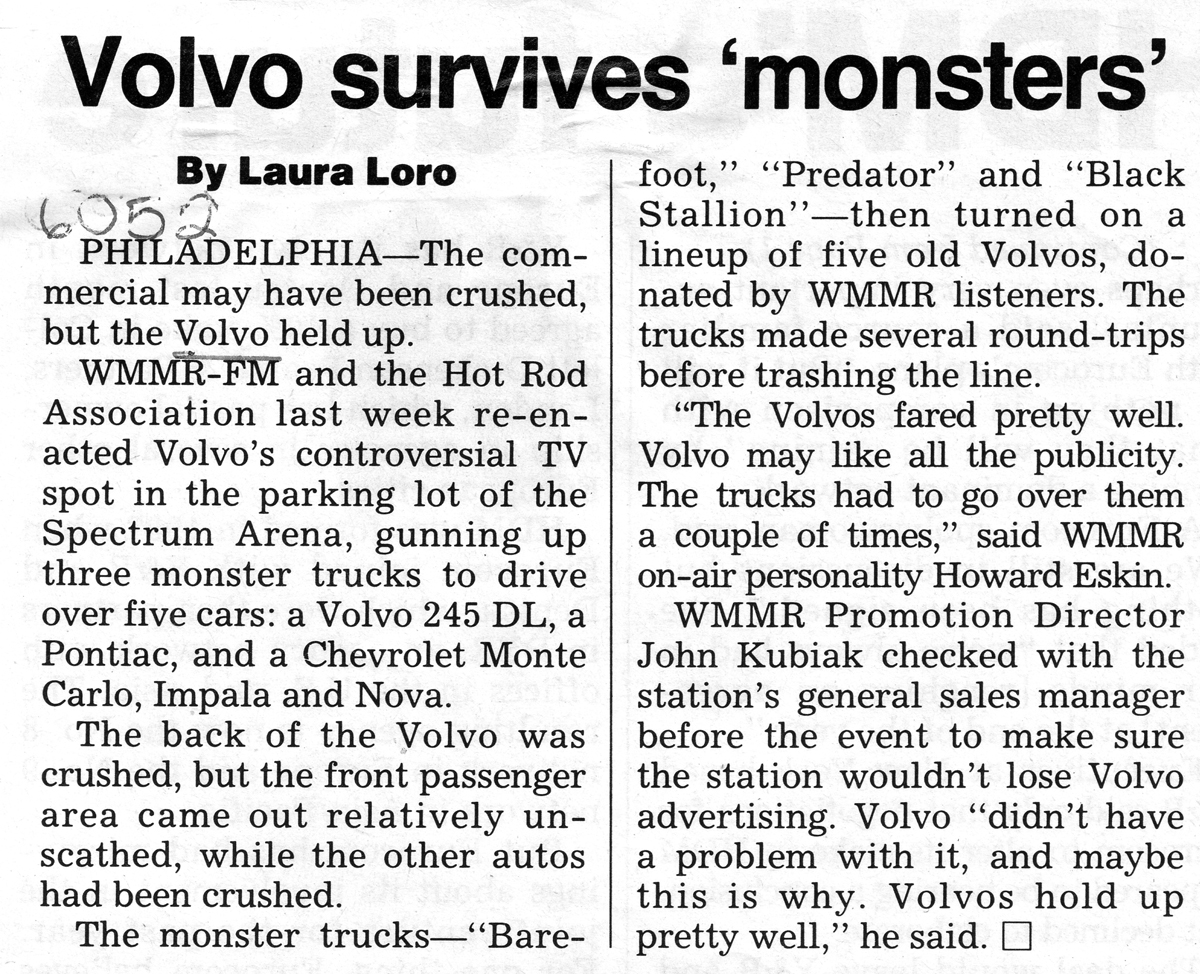
Volvo defies monster truck
In the wake of “Monster Truck,” Volvo adopted a strict policy stating “not a single foot of film for a Volvo commercial could be shot without a senior member of the Volvo advertising staff present.” No such staff member had been on location for the entirety of the “Monster Truck” shoot.
While Volvo would survive “Monster Truck” its storied relationship with Scali, McCabe, Sloves would not. On November 12, 1990, Scali, McCabe and Sloves resigned the $40 million Volvo account after producing 24-years of award-winning advertising.

Broken Monster Truck removed from defiant Volvo
Counter intuitively, Volvo 240 monthly sales increased 19 percent that November; sales increased another 38 percent the following month. It would seem that customers still believed in Volvo and said so with their checkbooks.
Beyond the media buzz, there was great irony in the “Monster Truck” saga. In the months after the story broke, the United States Hot Rod Association, the sanctioning body for monster truck events, embraced the global media frenzy. Around the nation the USHRA scheduled “Crush a Volvo” events as a headline grabber. However, the crushing didn’t go as planned. Even without that movie magic, and just as the Swedish engineers foresaw, Volvos really could withstand a monster truck’s abuses. As reported in the Pittsburgh Press after one such event, “Volvo was grudgingly declared the winner this morning after a monster truck trying to crush it ended up with a broken drive shaft.”
It appeared that not only could Volvos withstand brutal punishment, Volvos could even fight back.
In covering the event, USA Today reported that Volvo Spokesman Robert Austin stated, “Volvos really are tough. In fact we wouldn’t mind if they featured “new” Volvos for these events.”

A gripping story, brilliantly told. Kudos, Burton. And hats off to Bob!
Thank you for the positive comments. Yes Bob really gave the industry a “How to” on dealing with a corpotate crisis.